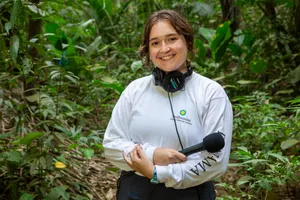SMITHSONIAN TROPICAL RESEARCH INSTITUTE
Red-Eyed Treefrog Eggs Hatch a Plan to Escape Warming Temperatures
A new study from the Smithsonian Tropical Research Institute (STRI) shows that red-eyed treefrog embryos hatch early when exposed to high ammonia levels — an environmental cue that it’s too hot and dry for the eggs to survive
:focal(2000x1333:2001x1334)/https://tf-cmsv2-smithsonianmag-media.s3.amazonaws.com/filer_public/b7/bf/b7bf255a-5134-4f1d-8661-93b3bff5bc8a/dsc_3895.jpg)
With their bright green coats, orange feet, and blue stripes, red-eyed treefrogs have become cover models for Central American rainforest conservation. Along with flashy accessories, they’ve evolved to hatch in response to environmental cues. This phenomenon helps them survive myriad jungle threats like hungry predators, dangerous pathogens, suffocating floods, and maybe even climate change.
Three decades ago, Dr. Karen Warkentin, current Boston University professor and STRI Research Associate, realized that red-eyed treefrog embryos can hatch up to three days shy of their normal seven-day development cycle. If they deem life in their gelatinous nursery to be too risky, they can slip out of their eggs and into the relative safety of the water below. But how do embryonic treefrogs make this call?
Warkentin discovered that red-eyed treefrog embryos are discerning observers of the sensory world around them, able to differentiate between the vibrations caused by a munching snake or hungry wasp and a harmless tropical storm. More recent studies showed that red-eyed treefrogs also hatch in response to hot, dry conditions that could be fatal.
One of Méndez’s volunteers, Astrid Katerina Lisondro-Arosemena, received an internship funded by STRI and the Panamanian National Secretariat of Sciences, Technology, and Innovation (SENACYT) to test whether elevated ammonia levels could trigger early hatching in red-eyed treefrogs in an otherwise safe, nurturing environment. Over the course of two years, Lisondro-Arosemena, a graduate from the Universidad Autonoma de Chiriquí and lead author on the newest paper from the Warkentin Lab, conducted experiments at STRI’s laboratory in Gamboa, Panama.
The study’s results linked ammonia exposure to near-immediate hatching in 95% of trials, uncovering one of the ways that embryonic treefrogs can sense oncoming climate danger. “I love it when the embryos give us such clear answers to our questions,” said Warkentin. The findings weren’t the only exciting part of the project; “we needed to figure out how to make [an experiment] no one had ever thought of before happen in the field, cheaply,” explained paper co-author and doctoral student at Boston University, María José Salazar-Nicholls. Salazar-Nicholls mentored Lisondro-Arosemena throughout the project, teaching her methods in developmental biology and troubleshooting experimental design in an ambient laboratory space in Gamboa, Panama. “Sometimes, the discovery comes in figuring out how to ask the embryos, ‘Why are you doing what you’re doing?’” said Warkentin.
Since she first worked with Warkentin as a STRI intern in 2016, Salazar-Nicholls has learned how to tell when embryos are happy, annoyed, or just about to hatch. “That internship introduced me to this field of frog embryo behavior that I didn’t know even existed ... and I fell in love."
Originally from Ecuador, Salazar-Nicholls didn’t speak English when she started working with Warkentin but learned through the lab’s bilingual environment, including Warkentin, who themself speaks Spanish. “If your leader invests the time and the effort into learning the language, if you receive training in your own language, you’ll immediately feel more welcomed,” said Salazar-Nicholls.

/https://tf-cmsv2-smithsonianmag-media.s3.amazonaws.com/filer_public/c2/d5/c2d5a2cf-5491-4171-a1f1-b559ee993b46/1_1_dsc_3872_copia1.jpg)
/https://tf-cmsv2-smithsonianmag-media.s3.amazonaws.com/filer_public/cc/b5/ccb51f80-a549-466e-9579-f44541ff1770/1_2_dsc_3622.jpg)
/https://tf-cmsv2-smithsonianmag-media.s3.amazonaws.com/filer_public/cd/cd/cdcd17ca-fe15-430b-ab61-d840f30c7cce/1_3_kmw5167_20160720_epmorning_small.jpg)
/https://tf-cmsv2-smithsonianmag-media.s3.amazonaws.com/filer_public/4f/89/4f89dd9c-e234-45d7-86ba-e858fbd51b5c/2_1_kmw_0682-20180718-stage25-lab.jpg)
/https://tf-cmsv2-smithsonianmag-media.s3.amazonaws.com/filer_public/69/ac/69ac938c-84e6-4ac2-a7e0-230a95dc5afb/2_2_esi_6259-2m16s-crops.jpg)
/https://tf-cmsv2-smithsonianmag-media.s3.amazonaws.com/filer_public/76/74/7674f40e-c120-488f-b1c2-1d321113d0ce/3_1_img_3793.jpeg)
/https://tf-cmsv2-smithsonianmag-media.s3.amazonaws.com/filer_public/d5/09/d5094ce9-dbbd-4374-b50f-888d639b6310/3_2_experimental_1.jpg)
/https://tf-cmsv2-smithsonianmag-media.s3.amazonaws.com/filer_public/26/77/26775aa1-645b-4743-a9cd-596baacc9c9b/3_3_experimental_2.jpg)


